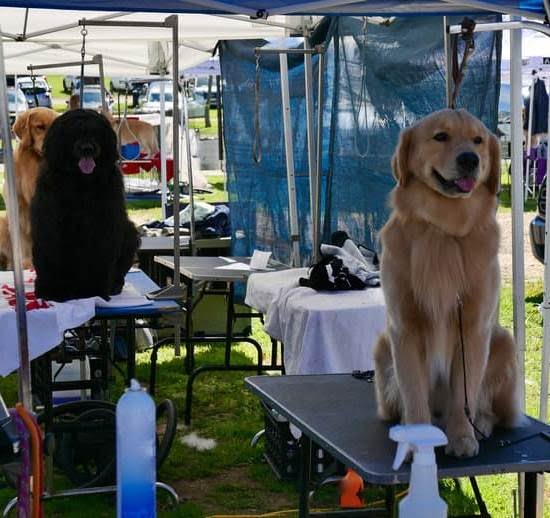Introduction
Dog training is a fascinating and rewarding field of study and work where trainers help to teach dogs good behaviors as well as resolve existing issues. Dog trainers are professionals that understand canine psychology, behavior, health, safety and training techniques to help teach owners how to address their current and long-term needs. The aim of the dog trainer is to manage and modify problem behavior while helping them learn new skills that can be applied in different situations. Many dog trainers focus on providing basic obedience training while more experienced dog trainers may pursue specializations in service or therapy dogs, agility courses, scent detection, protection/guard work and more.
For those interested in entering this fast-growing profession, becoming a professional dog trainer will require the appropriate knowledge and skill set. There are several steps someone must take in order to become a certified dog trainer including research into both local requirements as well as available certifications from national organizations like the Certification Council for Professional Dog Trainers (CCPDT). Those aspiring to become a certified dog trainer have the option of attending local training programs at designated institutions or remote learning through online coursework or distance learning modules. Depending on an individual’s location, classes can include specialized instruction on topics such as clicker training, operant conditioning and rewards-based training methods as well as breed-specific information. In addition to general seminars or classes geared towards instructing owners on how to behave around their dogs, some certification programs also offer hands-on experience with animals so learners can further hone their skills. Ultimately earning a certification validates dedication and commitment to becoming an effective member of the pet care community who can positively influence the lives of both pets and owners alike.
Analyzing Your Personal Strengths and Weaknesses for Dog Training
Before becoming a dog trainer, it is important to consider what skills and strengths you possess that could make you successful in this field. Dog training requires an understanding of canine behavior, the ability to clearly communicate training objectives, and the patience to dedicate time to building relationships with your clients and their pets. If you have experience working with animals or are naturally calm in a chaotic environment, these are definite strengths. As most dogs have fairly short attention spans and can quickly become bored or frustrated with a task if not properly motivated, having creative problem solving skills is also important.
On the other hand, there are some traits that can make dog training more difficult as well. If you struggle with communicating instructions in a clear way or lack patience when things don’t go right on the first try, these could be areas where you would need to work on increasing your skills before taking on any pet parents as clients. Lastly, depending on where you live and which types of services you plan to offer (ie: puppy classes vs specialized behavior modification), understanding how local regulations affect businesses in the pet industry may be something to consider when beginning your journey into dog training.
Exploring Different Types of Dog Training Certification
If you are looking to become a certified dog trainer, it is important to understand the different types of certifications available. Generally speaking, becoming certified means gaining knowledge and/or demonstrating that you have an advanced level of mastery of the skills needed as a dog trainer.
One commonly accepted type of certification is from the Certification Council for Professional Dog Trainers (CCPDT). This non-profit certification organization offers board certified professional programs for both aspiring and experienced trainers. To qualify for the CCPDT program, applicants must have formal education or experience in the field and pass an evaluation based on education, technical knowledge and professional experience.
Another option is to complete a specific curriculum or program offered by a private school that specializes in canine education. Most schools require that students complete courses in canine behavior science, medical terminology, ethology, class management, obedience training methods and more before achieving certification. In addition to completing coursework, most schools require hands-on practicum hours where students practice their training methods with real dogs; some may even require supplemental seminars or shadowing experienced trainers in live settings prior to certification completion.
Finally, certification may also come from affiliations with individual kennel clubs or organizations within the industry such as The Association of Pet Dog Trainers (APDT) or other programs recognized by professional associations such as The International Association of Animal Behavior Consultants (IAABC). To qualify for this type of certification through one of these organizations, applicants typically need to prove they have completed college coursework in animal sciences or behavior studies and demonstrate an acceptable level of hands on experience gained through either apprenticeships or working under the approval of an accredited trainer.
Finding and Evaluating Dog Training Schools and Programs
The best way to become a dog trainer is to seek out proper education and training in the field. This will help ensure that you have the necessary knowledge, certifications, and qualifications to establish yourself as a reliable canine professional. There are many different types of dog trainer schools or programs currently available, depending on your location and career ambitions. To find one that’s right for you, start by researching accredited trainers with experience in the type of training you want to specialize in (obedience, agility, behavioral correction) or certified programs that specialize in canine studies or canine behavior certificate courses.
You can also review course descriptions to gain an understanding of the type of technical instruction offered and whether it has contact instruction from actual professionals. Additionally, inquire about what kind of continuing education opportunities are available as well—continued learning means more current information and increased expertise for clients to trust. Finally, once you’ve narrowed down your options, consider reaching out directly to alumni from each program for more insight into their experience with their chosen school or program. This should give you invaluable insight into the specific tools and techniques taught so that you can make an informed decision before committing further time and money into pursuing this career path.
Understanding the Requirements of Becoming a Dog Trainer
Becoming a dog trainer requires more than just an affinity for animals; in order to be successful, you need to have some requisite skills and knowledge. A strong understanding of animal behavior, the ability to communicate with both canines and their humans, and the willingness to work long hours are all needed. Additionally, completing a formal education or certification program is often required if you want to run your own business.
When it comes to educational requirements, make sure you do your research since what’s expected of dog trainers varies from state-to-state. Some states may require licensure while other states may only require certification programs. You may also need specific experience working with dogs or completion of a certification portfolio depending on where you are located.
In terms of certifying courses, the two recognized authorities in the U.S are the Certification Council for Professional Dog Trainers (CCPDT) and the International Association of Animal Behavior Consultants (IAABC). Both organizations offer different levels of schooling designed specifically for those interested in becoming canine professionals including veterinary technicians and behaviorists.
Once your educational training is complete, there are a few other things you will need if you plan on running your own business: equipment such as crates, leashes, collars and clicker systems; liability insurance; advertising budgets; and access to at least one location for classes – either indoor or outdoor – depending on your area’s ordinances. Taking classes at local pet stores or specialty businesses is a great way to get started with getting some hands-on experience before offering private classes yourself. Finally, having an online presence is also crucial for any aspiring dog trainer who wants to build their business; creating a website and being active on social media – especially platforms like Youtube or Instagram – can help bring customers in and get your name out there!
Resources and Benefits of the Dog Training Industry
Getting certified as a dog trainer is a great way to give back to the canine community and make money at the same time. It is important to understand the resources available and benefits within this industry before getting started.
Resources- To become a dog trainer, there are many helpful resources that can provide support throughout the journey including: webinars, seminars, book/publications, associations and mentors. Webinars are educational recorded sessions that can be accessed online at virtually anytime. Seminars may also be offered on tips and tricks to help improve your knowledge of animal behavior and training. Publications such as books or articles can provide additional information on providing obedience skills or understanding how pets react in certain situations. Local associations might be able to connect you with current professionals in this field who you can reach out for advice or support. Mentorship programs provide an intimate setting for learning by working one-on-one with an instructor or other professional in the business.
Benefits- There are many benefits of joining the dog training industry beyond a paycheck. You will have giving back to others top of mind as you provide emotional support for both their pet and owner alike through helping them build their relationship by teaching new skills. You will have ample opportunity for physical activity as well through incorporating hands on activities like running and playing games into your lessons plans. Moreover, the work is emotionally rewarding due to seeing progress in your students over time developing your bond with them even further along with satisfaction from getting tailor results based on individual needs.
Realistic Career Expectations for Dog Trainers
Becoming a dog trainer requires knowledge, dedication and an understanding of animal behavior. Depending on the type of dog training approach you wish to pursue, there are various routes to becoming certified. Dog trainers who specialize in obedience training may choose to become certified through an organization such as the Certification Council for Professional Dog Trainers (CCPDT). Alternatively, science-based trainers could pursue certification through The Karen Pryor Academy or the International Association of Animal Behavior Consultants. If you just want to spread knowledge and awareness about positive rewards-based training approaches, such as clicker training, you could become a certified clicker trainer though the Karen Pryor Academy.
Regardless of certification route chosen, practical experience is essential in the field of dog training. It is common for individuals with experience in pet sitting, volunteering in animal shelters or interning with experienced trainers to move into a career as a professional trainers. Realistic expectations for this career would include flexible work hours and an income based on qualifications and experience level. Working as a trainer can sometimes involve difficult conditions such as long days, weekends or travel between appointments. Additionally, continued learning is important to stay up-to-date with latest developments in the field of animal behavior and best practices for teaching dog owners how to effectively manage their pets behaviour.
Closing Thoughts and Motivation for Becoming a Dog Trainer
Becoming a dog trainer is an incredibly rewarding career. It allows people to use their expertise and experience to help both pet owners and their furry friends. It is one of the few professions that can fulfill your need for personal growth while also helping other people. As a dog trainer, you will have the opportunity to support pet owners in navigating health concerns, destructive behaviors, and basic obedience training of their beloved animals. Training dogs can bring both joy and satisfaction, knowing that you are helping to create healthier relationships between pets and their owners. Above all else, the joy of working with animals on a daily basis is indescribable—and there’s no feeling like it!
To become a certified dog trainer requires hard work, patience and dedication. First off, aspiring trainers should consider choosing a niche within canine training—such as basic obedience or specialized behavior modification—as this could help successfully target potential clients. One may attend motivational seminars or workshops specific to developing skills for training dogs effectively as well as gain additional experience by volunteering at rescue organizations or shelters. Aspiring professional trainers should also consider completing an accredited online or in-person program from reputable institutions like The Academy of Dog Trainers or Animal Behavior College. This can give them the knowledge base they need in order to be successful not only in the classroom but also out in the field. With the right credentials, resources, and tools in hand, improving the lives of dogs through qualitydog care is possible!

Welcome to the blog! I am a professional dog trainer and have been working with dogs for many years. In this blog, I will be discussing various topics related to dog training, including tips, tricks, and advice. I hope you find this information helpful and informative. Thanks for reading!





